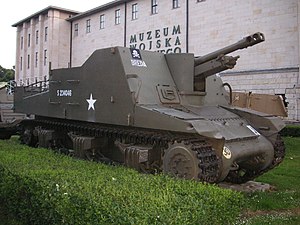Sexton (artillery)
| 25pdr SP, tracked, Sexton | |
|---|---|
 Sexton on exhibition in the Polish Army museum in Warsaw; this particular vehicle was used during WWII by the Polish 1st Armoured Division | |
| Type | Self-propelled artillery |
| Place of origin | |
| Service history | |
| In service | 1943 - 1956 |
| Used by | |
| Wars | Second World War |
| Production history | |
| Designed | 1942 |
| Manufacturer | Montreal Locomotive Works |
| No. built | 2,000 |
| Specifications | |
| Mass | 25.86 t |
| Length | 6.12 m (20 ft 1 in)[1] |
| Width | 2.71 m (8 ft 11 in)[1] |
| Height | 2.11 m (6 ft 11 in) |
| Crew | 6 [1](Commander, Driver, Gunner, Gun-Layer, Loader, Wireless) |
| Armour | up to 32 mm[1] |
Main armament | QF 25 pounder(87.6 mm) Mk II 112 rounds carried on board |
Secondary armament | Two 0.303 (7.7 mm) Bren LMG 50 30 Round Magazines |
| Engine | Continental R-975 9 cylinder Radial gasoline [1] 400 hp (298 kW)[1] |
| Suspension | volute spring |
Operational range | 200 km (125 miles)[1] |
| Maximum speed | 38 km/h (24 mph)[1] |
The 25pdr SP, tracked, Sexton was a self-propelled artillery vehicle of World War II, based on an American tank hull design, built by Canada for the British Army, and associated Commonwealth forces, and some of the other Allies.
History
In 1942, the US supplied enough M7 Priest self-propelled howitzers to equip a number of British Army artillery units in North Africa. The British found the Priest to be an excellent weapon, which gave artillery the same mobility as tank units. However, the Priest used the American 105 mm howitzer rather than the British equivalent, the 25 Pounder field gun. Having to supply different ammunition for a few units caused logistical problems for the British Army. The US attempted to fit a 25 pounder to the M7 Priest but the program suffered delays including the destruction of the gun mount on the prototype during the first live firing exercises.[1]
Meanwhile, the Army Engineering Design Branch of the Canadian government's Department of Munitions and Supply had set about designing a self-propelled version of the 25 Pounder field gun. A prototype of the vehicle, which was based on the Ram tank (itself a Canadian adaptation of the American Medium Tank M3, or M3 Lee), was completed on June 23, 1942. Following trials in Canada, the Canadian government ordered 124 vehicles in three batches. The prototype was shipped to the United Kingdom, where it underwent further trials; the vehicle was found to be highly satisfactory, and was designated the "Sexton" in May of 1943. The British government ordered 300 Sextons in the summer of 1943; however, these Sextons were to be built on Grizzly tank hulls (Canadian-built M4A1 Sherman tanks) instead of Ram tank hulls. The Ram-based Sexton was designated the Sexton I and the Grizzly-based Sexton was designated the Sexton II. British orders for the Sexton II eventually totalled 2,026 vehicles.
Between 1943 and 1945, the Montreal Locomotive Works manufactured a total of 2,150 Sextons for the use of both Canadian and British forces. The vehicle entered service in September 1943. The vehicles were first used in combat in Italy by the 8th army.[1]. Latter Sextons took an active part in the Battle of Normandy and the campaign in north-western Europe. During the D-day landings a number of sextons were ordered to fire from their landing craft as they approached the beaches although the fire didn't prove very accurate.[1]. In spite of its confused origins, the Sexton was a combination of proven parts and proved to be a successful design and remained in British service until 1956.
Unlike Germany, which often used its self-propelled guns in a front line direct fire role, Britain and Canada only used the Sexton for indirect supporting fire. They kept the Sextons well back from the front line and used forward observers to direct overwhelming fire on a target.
Variants
- Sexton I
- The first 125 vehicles manufactured.
- Sexton II
- Boxes added to the rear deck to carry batteries and an auxiliary generator to charge them.
- Sexton GPO (Gun Position Officer)
- The 25 pounder was removed and a No. 19 radio was added along with a map table; this vehicle was used to control battery fire.
References
External links
See also
- Yeramba - an Australian 1950s mounting of 25 pounder on an M3 hull.
